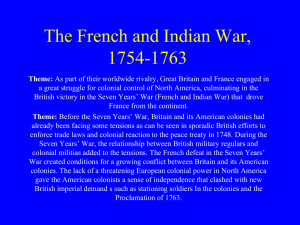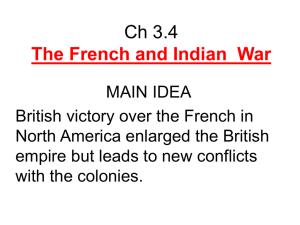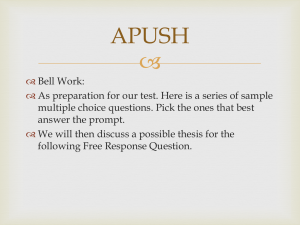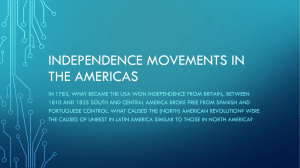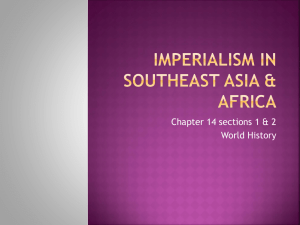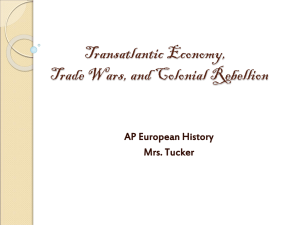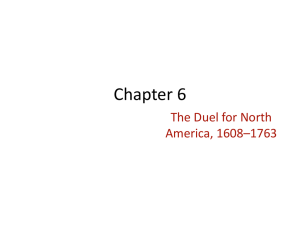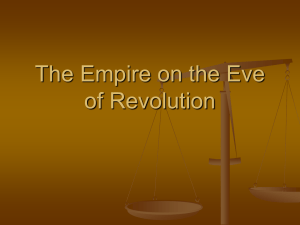French and Indian War
advertisement
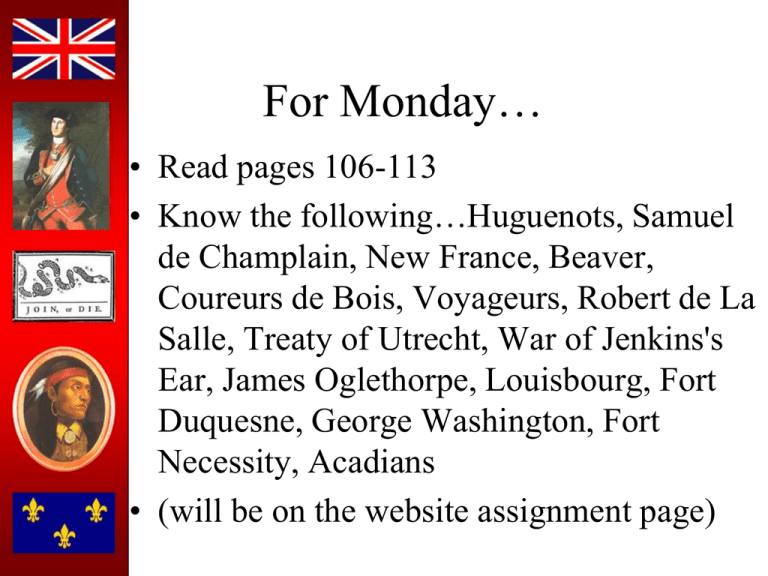
For Monday… • Read pages 106-113 • Know the following…Huguenots, Samuel de Champlain, New France, Beaver, Coureurs de Bois, Voyageurs, Robert de La Salle, Treaty of Utrecht, War of Jenkins's Ear, James Oglethorpe, Louisbourg, Fort Duquesne, George Washington, Fort Necessity, Acadians • (will be on the website assignment page) Bell Ringer… • How was the colony • Agenda and Objective: Through a group DBQ of New France paper project students will different from the be able to analyze various British North ways the French and American colonies? Indian war altered the political, economic, and ideological relations between Great Britain and the American Colonies. COLONIAL WARS Unit 1.6 Chapter 6 Theme As part of their worldwide imperial rivalry, Great Britain and France fought numerous wars for colonial control of North America, culminating in the British victory in the French and Indian War (Seven Years’ War) that resulted in France’s removal from the continent. DBQ! • This week you will be working independently and in groups to explain how the various colonial wars influenced economic, political, and ideological changes between the Colonies and Great Britain. DBQ! Independent Work • • • • • Read Chapter 6 Complete Study guide (due 10/22) Complete document analysis sheet Understand terms sheet Chapter 6 MC quiz on (10/22) DBQ Group work • You and your group will work together creating an essay to answer the 2004 APUSH DBQ • You will do this through the school’s google doc account. • You will be writing and editing throughout the week both in class and outside of class. • Essay is due FRIDAY! You will then peer edit papers using the AP DBQ rubric. COLONIAL WARS I. New France in Canada A. France was late in coming to the New World New France c. 1645 B. Quebec colony founded in 1608 1. Samuel de Champlain (“Father of New France”) 2. Became allies with the Hurons and battled against the federated Iroquois Indians - - Significance: France was kept out of much of the Ohio Valley C. Government 1. King ruled in autocratic fashion - - No popularly elected assemblies or trial by jury 2. Slow population growth - - Why? Louis XIV (16431715) Portrait by Hyacinthe Rigaud, 1701 D. French Expansion 1. Successful relations with Amerindians 2. Beaver trade led to exploration of North America a. Coureurs de bois b. Voyageurs 3. Jesuits sought to convert the Amerindians by example rather than by force 4. Posts in Mississippi region and Louisiana (New Orleans) --Purpose: block Spanish expansion into the Gulf of Mexico II. Clash of Empires: England, France, Spain A. Four world wars fought between Britain and France between 1689 and 1763 1. King William’s War (1689-1697) and Queen Anne’s War (1702-1713) a. British fought coureurs de bois and their Amerindian allies b. Treaty of Utrecht, 1713 c. “salutary neglect” 2. King George’s War (1744-1748) 1702 Map of North America in 1702 showing forts, towns and areas occupied by European settlements. Britain (pink), France (blue), and Spain terrestrial claim (orange) 1750 Map of territorial claims by 1750 in North America before the French and Indian War, that is part of the greater world-wide conflict known as the Seven Years' War (1756 to 1763). – possessions of Britain (pink), France (blue), and Spain (orange, 3. French and Indian War (1754-1763) (Seven Years’ War) a. Main issue: Ohio Valley b. George Washington’s Ohio mission -- Battle near Fort Duquesne, 1754 …and…. George got to start his very own world war! c. British clamped down on Nova Scotia d. War widened into the largest war in history, up to that time. e. Albany Congress (1754): Purposes i. Make Iroquois allies of Britain ii. Greater colonial unity and defense against France Benjamin Franklin, May, 1754 Albany Congress, 1754 f. Benjamin Franklin’s plan: Albany Plan for Union i. Colonial home rule - - Adopted by delegates ii. Rejected -- Individual colonies: “not enough independence” -- British: “gave too much independence” iii. Significance: First major step towards colonial political unity g. General Braddock defeated near Fort Duquesne, 1755 Braddock’s defeat: “…who would have thought it?” h. William Pitt, “The Great Commoner”: Leader in Parliament -- Took control of the war and led Britain to victory. i. Fall of Quebec (1760) -- One of most significant battles in British & U.S. history -- Resulted in France’s defeat j. Peace of Paris (1763) -- French completely removed from North America -- France ceded all MississippiLouisiana region to Spain -- Spain gave Florida to Britain in return for Cuba -- British emerged as dominant power in North America Territorial changes following the French and Indian War: land held by the British before 1763 is shown in red, land gained by Britain in 1763 is shown in pink III. Friction between the colonies and the mother country A. American confidence & frustration 1. Colonist contributions 2. British vulnerability 3. British contempt B. Some colonial resistance to war effort infuriated Britain 1. American shipping 2. Aid to Indians 3. British forbidding of exports 4. Some colonial resistance to war effort C. Increased colonial expansion -- Spanish & French barriers gone D. Pontiac’s Rebellion (1763) E. Proclamation of 1763 1. Prohibited colonials to move west of the Appalachian Mountains 2. British motive: Settle land disputes with Indians fairly 3. Colonists infuriated a. Veterans b. Land speculators 4. Law generally ignored Map showing the Proclamation Line of 1763
